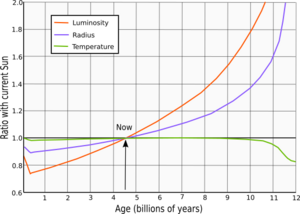Solar luminosity facts for kids
The solar luminosity is a way astronomers measure how much light and energy a star, galaxy, or other space object gives off. It compares their brightness to the Sun's brightness. Think of it as the Sun's total power output in the form of light.
The International Astronomical Union (IAU) says that one standard solar luminosity is about 3.828 followed by 26 zeros watts (3.828 x 1026 watts). A watt is a unit of power. This number doesn't include the energy from tiny particles called neutrinos that the Sun also sends out. If you add the neutrino energy, the Sun's total power output is slightly higher.
The Sun is a bit like a variable star, meaning its brightness changes a little over time. The biggest change happens during the eleven-year solar cycle, which is linked to sunspots. During this cycle, the Sun's brightness can change by about 0.1%. Other changes over the last few hundred years have been much smaller.
How We Measure Solar Luminosity
Solar luminosity is connected to something called solar irradiance, which is often called the solar constant. The solar constant is the amount of the Sun's energy that reaches Earth's atmosphere. This energy is important because it affects Earth's climate and causes things like the Milankovitch cycles, which are linked to ice ages.
Imagine the Sun's energy spreading out in all directions. By measuring how much energy reaches Earth (the solar constant), scientists can figure out the Sun's total power. They do this by multiplying the solar constant by the area of a giant imaginary sphere. This sphere has the Sun at its center and reaches all the way to Earth. This calculation helps us understand the total energy the Sun sends into space.
See also
 In Spanish: Luminosidad solar para niños
In Spanish: Luminosidad solar para niños
- Sun
- Solar mass
- Solar radius
- Nuclear fusion
- Active region
- Triple-alpha process


